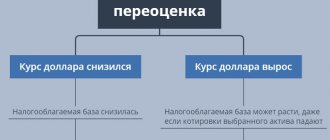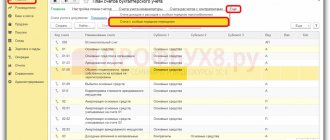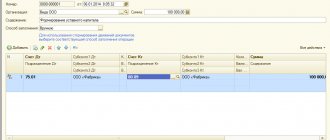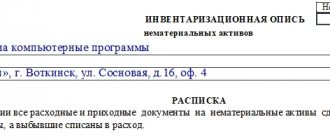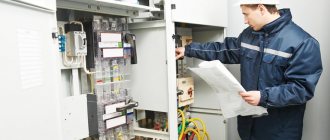Revaluation of non-current assets in the balance sheet is
Line 1340
reflects the amount of increase in the value of non-current assets, identified based on the results of their revaluation:
[Credit balance on account 83 “Additional capital”] (in terms of amounts of additional valuation of fixed assets and intangible assets)
A commercial organization can no more than once a year (at the end of the reporting period) year) revaluate groups of similar fixed assets at current (replacement) cost.
When making a decision on revaluation of such fixed assets, it should be taken into account that subsequently they are revalued regularly so that the cost of fixed assets at which they are reflected in accounting and reporting does not differ significantly from the current (replacement) cost.
Revaluation of an object of fixed assets is carried out by recalculating its original cost or current (replacement) cost, if this object was revalued earlier, and the amount of depreciation accrued for the entire period of use of the object.
The results of the revaluation of fixed assets carried out at the end of the reporting year are subject to reflection in accounting separately.
The amount of revaluation of an object of fixed assets as a result of revaluation is credited to the additional capital of the organization. The amount of revaluation of an item of fixed assets, equal to the amount of its depreciation carried out in previous reporting periods and attributed to the financial result as other expenses, is credited to the financial result as other income.
The amount of depreciation of an item of fixed assets as a result of revaluation is included in the financial result as other expenses. The amount of depreciation of an object of fixed assets is included in the reduction of the organization’s additional capital formed from the amounts of the additional valuation of this object carried out in previous reporting periods. The excess of the amount of depreciation of an object over the amount of its revaluation, credited to the organization's additional capital as a result of revaluation carried out in previous reporting periods, is charged to the account of retained earnings (uncovered loss).
When an item of fixed assets is disposed of, the amount of its revaluation is transferred from the organization's additional capital to the organization's retained earnings.
The amount of additional valuation of intangible assets as a result of revaluation is credited to the additional capital of the organization. The amount of revaluation of an intangible asset, equal to the amount of its depreciation carried out in previous reporting years and attributed to the financial result as other expenses, is credited to the financial result as other income.
The amount of write-down of an intangible asset as a result of revaluation is included in the financial result as other expenses. The amount of the writedown of an intangible asset is included in the reduction of the organization’s additional capital formed from the amounts of the additional valuation of this asset carried out in previous reporting years. The excess of the amount of depreciation of an intangible asset over the amount of its revaluation credited to the organization's additional capital as a result of revaluation carried out in previous reporting years is charged to the financial result as other expenses.
When an intangible asset is disposed of, the amount of its revaluation is transferred from the organization’s additional capital to the organization’s retained earnings (uncovered loss) account.
The results of the revaluation of intangible assets carried out at the end of the reporting year are subject to reflection in accounting separately.
Where is the revaluation of non-current assets recorded: line 1340
Balance sheet line 1340 “Revaluation of non-current assets” is specially set aside to reflect the results of the revaluation of fixed assets and intangible assets. The amount indicated in it corresponds to the credit balance of account 83, since the revaluation of non-current assets is included in equity capital.
Its postings accompanying the revaluation procedure are generated:
| Operations | D/t | K/t |
| The value of the asset was increased at the first revaluation | 01, 04 | 83 |
| Added depreciation amount for it | 83 | 02, 05 |
| The cost of the object was reduced during the first markdown | 91 | 01, 04 |
| Reduced depreciation | 02, 05 | 91 |
| Disposal of property that was previously overvalued | 83 | 84 |
Further revaluations are carried out from the replacement cost of objects, increasing the amount of additional capital when revaluing, or assigning the amount of the markdown to other expenses.
Revaluation of non-current assets
Related publications
Revaluation of non-current assets in the balance sheet is the amount of increase in their value resulting from the revaluation. This information is reflected in the 3rd section of the liabilities side of the balance sheet, participating in changes in the volume of retained earnings and separately highlighting the amount of revaluation of fixed assets and intangible assets. This will be discussed in the article.
Formulas for conducting PI
Since the revaluation of non-current assets concerns not only items of property, but also the amount of accumulated depreciation, then first you need to calculate the depreciation (including accumulated) at the time of the transaction. There are four methods for calculating depreciation, so we will skip this step.
On the subject: DIY candy boxes: original ideas, step-by-step description
Direct conversion method
After determining the market price of the revalued item, you need to use the formula:
O = RS / PS * 100 – 100, where
- О – deviation in price as a percentage;
- RS – market value;
- PV – the original or current restoration price if the item has previously been revalued.
After calculation, you should get a percentage (positive or negative).
If the positive percentage is more than 5%, then this is a signal for an increase in the value of a non-current asset, and additional valuation needs to be carried out. If the negative percentage is less than 5%, a markdown should be carried out. The value of revaluation or discount is the difference between the original and replacement price. Next you need to recalculate depreciation:
PA = A * O, where
- PA – recalculated depreciation;
- A – depreciation (including accumulated);
- O – price deviation as a percentage.
Index method or indexing method
In this case, the replacement (market) price is determined not using external information, as in the case of direct recalculation, but is calculated using deflator indices:
BC = PS * ID1 * ID2 * ID3 * ID4, where
- ВС – replacement price;
- PS - the original or current replacement cost, if the item has previously been revalued;
- ID1-ID4 – deflator indices for SAI for four quarters of the reporting year.
After calculating the replacement price, further actions are similar to those for recalculating prices directly. After these calculations and accounting for PI in the accounts (more on this below), the revaluation of non-current assets is reflected in the balance sheet. This is the final stage of this procedure.
Which assets are overvalued and why?
Revaluation is possible for long-term financial investments, fixed assets and intangible assets. It is practiced to smooth out the difference between the original price of an object and its market value at a certain point in time. It is believed that a five percent gap between these two indicators is a reason for revaluation. It should be noted that revaluation is not a mandatory procedure; it may not be carried out until the need arises. However, the company does not have the right to revalue the property whenever it wants. This decision must be recorded in the UP.
All property of the company may be subject to revaluation, or categories of similar items may be formed, which the company has the right to determine independently.
There are many reasons for revaluation. For example, an organization plans to sell part of its assets, or wants to attract investment, for which it needs to obtain a loan, etc. In addition, companies have to control the value of net assets, which should not fall below the size of the company's authorized capital.
What is the point of holding a PI?
As was already mentioned at the beginning of the article, prices for various things that can become the SAI of a company are constantly changing. Revaluation of non-current assets allows you to equalize the original cost of these assets and make them the same as the prices on the market at a given time.
There are many reasons for PI. It must be carried out if it is necessary to sell part of the property or the entire company as a whole. If a company decides to attract investment, it is also necessary to conduct an investment project if the attraction concerns obtaining a loan. To do this, the price of the collateral must be reliably determined. And since the collateral is the company’s property, it is impossible to do without PI. If a decision is made to place (issue) securities, a revaluation of property is also carried out, since the authorities must know the real financial position of the company (issuer) that will issue securities into circulation.
Simply for the sake of improving investment attractiveness for potential investors, PI is also necessary. If the company's net assets fall below its authorized capital, the company risks going bankrupt. Therefore, to clarify the value of assets, a revaluation of property is also necessary. If a decision is made to insure property, an insurance base must be formed. PI is also needed here. Also, the reasons for revaluation include processes of mergers and acquisitions of companies, especially if these processes concern foreign companies operating under the international financial reporting standard (IFRS). In such cases, PI is mandatory. When an item of property becomes obsolete, when its market price drops sharply against the background of new developments, revaluation makes it possible to equalize the cost of existing items with their market price for more accurate information about the financial situation of society. There are other reasons for PI.
Revaluation of non-current assets (fixed assets and intangible assets): how to take into account?
Commercial companies have the right to revalue homogeneous categories of fixed assets at current (replacement) cost no more than once a year. The procedure is carried out by recalculating the initial value of the object (or already the replacement value, if this is not the first revaluation) and the amount of depreciation accrued during the period of its use. Those. simultaneously with the change in the value of the fixed asset/intangible asset, the amount of accrued depreciation is proportionally recalculated.
Revaluation pursues the goal of bringing the accounting value of an asset as close as possible to its market value, which, based on market realities, can either increase or decrease. Therefore, depending on various circumstances, both an additional valuation (increase in value) and a markdown, i.e. its reduction, can be carried out. The results of the revaluation of fixed assets and intangible assets are reflected in the company’s accounting:
- The additional valuation is recorded in additional capital (account 83);
- The markdown is included in the financial result as another expense (account 91).
When disposing of fixed assets or intangible assets, their increased value from additional capital is transferred to retained earnings.
What can be overvalued in non-current assets?
The latest edition (dated 04/06/2015) of the full form of the balance sheet, approved by order No. 66n dated 07/02/2010, divides non-current assets into 9 lines, which essentially contain data on 5 types of assets:
- OS (this includes lines for OS, profitable investments, material exploration assets).
- Intangible assets (these are lines for intangible assets, R&D, intangible exploration assets).
- Unfinished investments in fixed assets and intangible assets (data on them in the balance sheet is either distributed between the lines of fixed assets and intangible assets, or allocated to the line of other assets).
- Long-term (for a period of more than a year) financial investments.
- SHE.
Revaluation rules
The revaluation of non-current assets is subject to a number of rules:
- It is voluntary (except for situations requiring the revaluation of securities). Therefore, the decision to carry it out (or not) must be reflected in the accounting policies.
- The fact of making a decision to conduct a revaluation makes it mandatory in relation to selected groups of fixed assets and intangible assets at the end of each reporting year (clause 15 of PBU 06/1, clause 18 of PBU 14/2007). Mandatory revaluation of financial investments is carried out at the organization's discretion monthly, quarterly or once at the end of the year (clause 20 of PBU 19/02).
- Revaluation involves bringing the accounting value of assets to their current market value. Therefore, this cost must be documented. And since both an increase and a decrease in value are possible on the market, both revaluation and depreciation will occur in relation to assets.
- When revaluing depreciable property (fixed assets or intangible assets), simultaneously with a change in the value of the asset itself, the amounts of depreciation accrued on it are recalculated in a similar proportion, i.e., essentially, the residual value of the asset is revalued.
Accounting for revaluation and reflection in the balance sheet
Each change in the value of financial investments is attributed to the current financial result (clause 20 of PBU 19/02), which is expressed in the transactions:
Dt 58 Kt 91 – cost increased to market value (income received);
Dt 91 Kt 58 – cost reduced to market value (consumption reflected).
Accordingly, the revaluation of financial investments will participate in the formation of the total amount of the current financial result (account 99) and in the balance sheet will appear in the “Capital and Reserves” section on the line “Retained earnings (uncovered loss)”, reflected there together with the balance of account 84.
The revaluation carried out in relation to fixed assets and intangible assets is shown in accounting according to the same rules (clause 15 of PBU 06/1 and clause 21 of PBU 14/2007):
- The first revaluation (an increase in the value of an asset with a simultaneous commensurate increase in the depreciation accrued on it) goes to additional capital (account 83) to its separate subaccount in two entries:
Dt 01, 04 Kt 83 – asset value added;
Dt 83 Kt 02, 05 – depreciation has been added for it.
- The first markdown (a decrease in the value of an asset with a simultaneous commensurate decrease in the depreciation accrued on it) is reflected in the current financial result:
Dt 91 Kt 01, 04 – asset value reduced;
Dt 02, 05 Kt 91 – depreciation on it has been reduced.
Subsequent revaluations are made from the current (replacement) value (i.e. from what was already revalued earlier) taking into account the previous result:
- An additional valuation to an existing revaluation will increase the amount reflected in account 83 by transactions similar to those made during the first revaluation.
- An additional valuation in the event that there was previously a markdown should be attributed to account 83 only to the extent that exceeds the previous markdown. Accruals within the amount of the previous markdown will be taken into account in the financial result by postings that are reverse to those made during the first markdown:
Dt 01, 04 Kt 91 – asset value added;
Dt 91 Kt 02, 05 – depreciation has been added for it.
- A markdown carried out after a previously occurring revaluation reduces the amount listed on account 83 by postings that are reverse to those made during the first revaluation:
Dt 83 Kt 01, 04 – asset value reduced;
Dt 02, 05 Kt 83 – depreciation on it has been reduced.
If the amount of the markdown exceeds the amount of the existing revaluation, then the amount of this excess must be included in the financial result using entries similar to those made during the first markdown.
- A markdown carried out following a previous markdown is recorded by additional postings similar to those made during the first markdown.
In the event of disposal of an asset, the amount of additional valuation on it, listed in account 83, increases the amount of retained earnings: Dt 83 Kt 84.
Thus, in the balance sheet in the “Capital and Reserves” section, the line “Revaluation of non-current assets” will only include the balance according to the corresponding analytics available in account 83, i.e. the total of the recorded amount of revaluation (increase in asset value). In all other situations, the process of revaluation of fixed assets and intangible assets will be reflected in the current financial result (account 99) and will participate in the generation of data on the line “Retained earnings (uncovered loss)” together with the balance on account 84.
To learn about the value of fixed assets and intangible assets to calculate the property tax base, read the material “How to determine the residual value of fixed assets .
PI delivery system
If an item is revalued for the first time, then its revaluation is credited to account 83 “Additional capital”, and the markdown is credited to account 91.2 “Other income and expenses”. If PI is carried out at the beginning of the year, then in case of markdown the value is debited to account 84 “Retained earnings (uncovered loss)”. The depreciation calculated using the formula above should also be reestimated. The same entries are made, only the debits and credits are swapped, and depreciation accounts are used. There is nothing complicated here.
The most interesting thing begins if the item has already been revalued before. If this happens, then the new revaluation is applied to additional capital. If it is equal to the old markdown, then it is credited to account 91.1. If the revaluation is greater than the previous markdown, then its residual value goes into additional capital.
If the item has already been overvalued, the additional capital is reduced by the value of the markdown. If it is greater than the previous value, then first the additional capital is reduced by the value of the previous revaluation, and the residual value of the markdown goes to account 91.1 if the procedure is carried out at the end of the year (December 31), or to account 84 if the markdown occurs at the beginning (January 1) .
On the subject: Features of life in London: work, real estate, advantages and disadvantages
If the item has already been marked down, then the new value is applied to account 91.2 or to account 84 if the markdown occurs at the beginning of the year.
Revaluation of assets. What should you keep in mind?
Agricultural organizations can clarify the value of assets. In relation to fixed assets, this can be done using revaluation. Organizations decide on their own whether to conduct it or not. But it should be taken into account that in accounting, revaluation must be considered in conjunction with the reflection of transactions in accounting accounts and in reporting, as well as assessing the tax consequences. As a rule, such an event is held in the first quarter.
We organize revaluation
Revaluation of non-current assets
Non-current assets in accounting are property that is used by a company in business activities for more than a year, transferring its value to the cost of finished products in parts and capable of generating income for the organization. Non-current assets include fixed assets (PBU 19/02), deferred tax assets, as well as other non-current assets (Order of the Ministry of Finance of Russia dated July 2, 2010 N 66n). The classification of non-current assets is given in a separate consultation.
Account 08 “Investments in non-current assets” is used to reflect acquired non-current assets and collect costs to bring the asset to a state suitable for use in the organization’s activities.
Non-current assets are the fundamental basis of an organization's production process. The final financial result of the organization depends on how they are formed at the initial stage of creating a company, how non-current assets are managed in the future, and how effectively they are used in the business process. To assess the current structure and condition of fixed production assets, as well as the efficiency of their use, an analysis of non-current assets is carried out.
Analysis of non-current assets
When analyzing non-current assets to assess the condition of fixed assets, the following indicators are determined:
- depreciation rate, which determines how worn out the assets are;
- serviceability coefficient used in assessing the obsolescence of assets;
- retirement ratio, showing the share of assets retired from operation;
- renewal coefficient, which determines the share of received assets at the end of the year;
- and other indicators.
When analyzing non-current assets in order to determine the efficiency of using fixed assets, the following indicators are calculated:
- turnover ratio of non-current assets (capital productivity), the growth of which indicates an increase in the efficiency of assets;
- coefficient of investment activity of fixed assets;
- return on assets, the growth of which indicates an increase in the efficiency of use of assets (read more about the profitability of non-current assets in a separate consultation;
- and other indicators.
In addition to analyzing fixed production assets, a company can carry out a revaluation of non-current assets, which is a revision of the cost at which certain property of the organization was acquired by comparing this value with the current (replacement) value.
Revaluation of non-current assets
Revaluation of non-current assets is carried out on the basis of a decision to carry it out. Information about the revaluation of fixed production assets (which assets are subject to revaluation, the frequency of its implementation, etc.) will need to be fixed in the accounting policy of the organization.
When making a decision on the revaluation of a group of similar objects of fixed assets and intangible assets, their assessment at current (replacement) cost must be carried out regularly at the end of the reporting year (no more than once a year) (clause 15 of PBU 6/01, clause 17, clause 18 of PBU 14/2007).
The company must reassess the value of financial investments (securities), for which a procedure has been established for determining their current market value. Subsequent assessment of financial investments can be carried out by the organization, at its choice, monthly, quarterly or once at the end of the year (clause 20 of PBU 19/02). Small businesses are exempt from revaluation of financial investments (clause 19 of PBU 19/02).
Based on the results of the revaluation, fixed assets or intangible assets can be either discounted or overvalued. The amounts by which fixed assets or intangible assets have been discounted are reflected in account 91 “Other income and expenses” separately in the subaccounts “Revaluation of fixed assets” and “Revaluation of intangible assets” and are included in the financial result. And the amounts by which fixed assets or intangible assets were overvalued are recorded on account 83 “Additional capital” separately in the context of the subaccounts “Revaluation of fixed assets” and “Revaluation of intangible assets”. When revaluing depreciable property, simultaneously with a change in its value, the amount of depreciation accrued on it is also recalculated (clause 15 PBU 6/01, clause 21 PBU 14/2007).
Changes in the value of financial investments are reflected in account 91 “Other income and expenses” and are included in the financial result (clause 20 of PBU 19/02).
Please note that for tax purposes, revaluation of fixed assets or intangible assets is not carried out.
Carrying out revaluation
The decision to conduct a revaluation is made by the sole executive body of the enterprise, or its founders, if there is a need to increase the authorized capital or sell the company. The decision specifies the timing of the activities, as well as the list of assets subject to revaluation.
Odds
One of the options for establishing the current value of assets is to use coefficients for the revaluation of fixed assets and intangible assets. Current coefficients are currently not published by the federal agency Rosstat of the Russian Federation, although the possibility of their use is directly stated in PBU 6/01. Formally, an enterprise can apply for the development of these indices on a reimbursable basis, but in practice this revaluation option is used extremely rarely.
It must be taken into account that the use of one of the two options for revaluation actions must be recorded in the accounting policy of the enterprise. Only under this condition will revaluation not create problems during inspections by control and supervisory authorities.
Revaluation of fixed assets and reserve for doubtful debts - the topic of the video below:
Sum
The most common option is revaluation carried out by direct recalculation based on their current market prices. In this case, the company can use the following methods to determine the current price of fixed assets:
- obtaining reliable information on similar objects or intangible assets, including information from direct manufacturers;
- information about the current price level published in official sources of information or specialized literature;
- conducting an examination to determine the current value of property and intangible assets classified as fixed assets;
- contacting professional appraisers to prepare a report on the market value of objects.
Objective information about the current value obtained during the revaluation is subject to inclusion in the accounting data in the form of a specific amount.
It must be taken into account that, according to objective data, the value of fixed assets can not only decrease, but also increase (for example, with a significant increase in market prices for real estate).
Procedure
To carry out revaluation activities, the following algorithm of actions must be followed:
- approval of an internal decision to conduct an initial or subsequent revaluation - this administrative act is adopted by the head of the company, including on the basis of the decision of the founders;
- Based on the content of this decision, responsible persons establish the actual availability of fixed assets subject to revaluation, and also draw up the necessary technical documentation;
- the actual revaluation takes place through an internal examination of the condition of the objects, or through the involvement of independent experts and appraisers;
- establishing the current value occurs by obtaining objective data on the market value of an object or intangible asset (if these actions are performed by an appraiser or expert, this is included in the services for preparing a report);
- the results of the revaluation are approved by the decision of the company's management and are subject to accounting.
The total amount obtained during the revaluation will be used in the current activities of the enterprise and in the preparation of financial statements.
results
Approval of the revaluation results occurs in accordance with the provisions of the accounting policies approved by the enterprise. As a rule, the final report is approved by the manager alone, and if the revaluation is related to a change in the authorized capital or sale of the company, a general meeting of founders is held to approve this issue.
The approved decision will be the legal basis for the economic service of the enterprise to make appropriate changes to the accounting information. A similar procedure will accompany each subsequent revaluation of fixed assets.
Revaluation of non-current assets in the balance sheet
Revaluation of non-current assets in the balance sheet is a separate line with code 1340 in Section III “Capital and Reserves”, which indicates the balance of account 83 (analytical accounts of the amounts of revaluation of fixed assets and intangible assets) (Order of the Ministry of Finance of Russia dated July 2, 2010 N 66n, clause 15 PBU 6/01, clause 21 PBU 14/2007).
The amounts of depreciation of fixed assets and intangible assets, as well as the results of the revaluation of financial investments are reflected in account 99 “Profits and losses” and are used to generate balance sheet data on line 1370 “Retained earnings (uncovered loss)” (Order of the Ministry of Finance of Russia dated July 2, 2010 N 66n, clause 15 PBU 6/01, clause 21 PBU 14/2007, clause 20 PBU 19/02).
Brief information on the revaluation of non-current assets and line 1340 of the balance sheet
Before we begin a detailed review on the topic of revaluation of non-current assets and the procedure for filling out line 1340 of the Balance Sheet, we provide here basic information about the following material:
Take our proprietary course on choosing stocks on the stock market → training course
- line 1340 “Revaluation of non-current assets” reflects the amount of increase in the value of non-current assets, which is discovered based on the results of their revaluation;
- to form the value of line 1340, information on the credit balance of account 83 is used, as well as analytical accounts for accounting for exploration assets, intangible assets and amounts of additional valuation of fixed assets as of the reporting date;
- the amount of increase in the value of non-current assets is reflected separately in account 83 “Additional capital”;
- in the general case, the indicators of line 1340 as of December 31.– of the previous and preceding previous periods are subject to transfer from the balance sheet for the previous year;
- additional capital that arises due to the revaluation of non-current assets must be written off to the retained earnings (uncovered loss) of the company at the time of disposal of assets that have been revalued.

